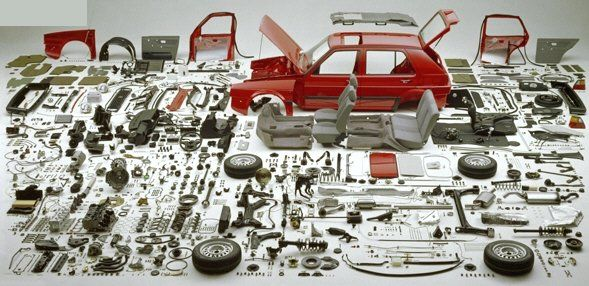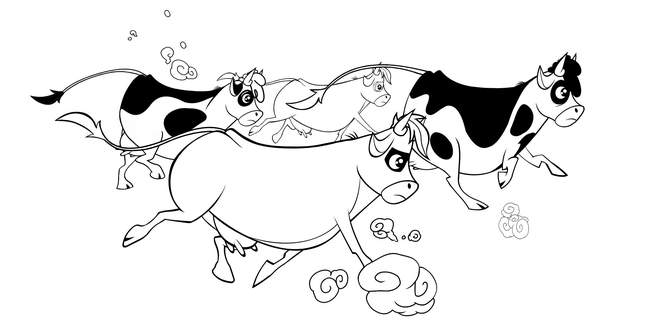Emergence and metasystem transition
In order for a set of physical parts to be considered a system, in addition to acknowledging the fact that this system is part of a supra system and has sub-system parts itself, another condition must be met: this system as a set of interacting sub-system parts must exhibit a certain property that is not present in its sub-system parts, leading to the possibility of a new function of the whole system, which includes the sub-system parts. This phenomenon is called emergence (system effect). Furthermore, this property and new function disappear in the supra system, where the considered system is included (but in return, the supra system gains new/emergent properties which differ from the properties of the system as its part, and this system effect is observed at each transition from one system level to another).
Time indication is not present in the arrows::part of a mechanical clock, nor in their gears::part, nor in the case::part, nor in the spring::part. However, in the clock::whole, the indication of time during their operation is possible — because of the interaction among their parts. Each part of the clock performs its function within the clock as a whole, and a system effect emerges: the clock starts showing time for the supra system in the system environment. But, in a room (and even in a smaller subsystem of the room where the clock is placed — the interior), time is not indicated, although the clock's time display is available and makes it more convenient to live in.
Note: crossing the boundary with the attention of the system level (also known as metasystem transition) changes everything, it is literally evident in discussions about systems, and visible in the text of descriptions:
- some roles in projects related to clocks specialize in methods that alter the state of assembled and working clocks (using the emergent property of time display, creating a room interior with different emergent properties than the clocks), during work with the clocks, the word "time" is regularly used as something that needs to be observed (for example, whether an additional lamp is needed to see the dial of the mechanical clock at night, "checking the time"), and there is no mention of materials for the clock parts (this is two system levels down from the interior: the clocks themselves and further down the details — their materials)
- other roles are engaged in clock assembly methods (creating a system with emergent clock properties), the displayed time concerns them in terms of accuracy of operation, not usage.
- third roles do not mention the clocks themselves but simply manufacture their parts, taking an interest in durability and methods of metal processing — gears, springs, casing. These parts also have emergent properties, behaving and characterized very differently from isolated atoms that make up these parts.
- ... one can go further down the system levels: some other roles deal with the materials of the clock parts: their durability, expansion when heated, etc. — and this reflects in the speech of agents in these roles as the use of completely different terminology.
Of course, all these system levels are coordinated with each other, and in discussions with clock assemblers, both the material (its properties affecting the properties of gears and hands) and time (the clocks need to be set up so that the gears and hands display the correct time), and even the interior of the house (discussions of mounting the clock on the wall, the size of the clock face to make it visible through the room) are mentioned regularly. However, each system level differs in its systems, manifesting some properties, changing their states during operation and during creation out of them of metasystems by methods of creating these systems and metasystems from these systems (some systems need to be cast in forms from molten metal, some need to be assembled from parts, like panel houses, some require training, like a skill). These methods change the states of system parts to obtain a whole system and set it in motion.
Different methods of constructing and developing systems are performed by different roles in the system creation, these roles speak a characteristic language, discussing systems of the same system level. As we will see further — even with a set of languages since different roles specializing in discussing problems at a certain system level use different languages to pursue their interests.
Different roles lead to the specialization of agents in mastering the methods of performing these roles. Agents specializing in systems at different system levels will also differ. People (or even AI, or units) engaged in designing and manufacturing clocks are not the same as those involved in interiors, nor are they the same as those involved in the materials for the clock parts. This is the division of labor: different work methods are used in projects not by themselves (they are deeply related to the emergence of some property), but by the emergence of some property, and the collaboration at different system levels in the attention of the roles involved.
Attention transition from one system level to another — changes the leading roles of the creators, changes their work methods and the objects of these methods, the terminology of these work cultures/languages. This change is due to the different set of concepts that express the objects of attention of the system level: as attention shifts from systems of one system level to systems of another level, the concepts for the parts of the system and its important properties change, thus changing the terminology for expressing these concepts.
An organism::the whole of an animal jumps and runs when used, but its organs::parts — don't. Jumping::behavior and running::behavior are emergent functions of an organism. Organs perform actions inside the organism, they have functions in the organism (for example, muscles contract, the liver cleanses the blood, the lungs saturate it with oxygen and rid it of carbon dioxide), this is the manifestation of their systemic/emergent properties as complete organs, individual cells within the organs (parts of the organs) cannot do this themselves, although it's the cells inside the organs that do everything in their interaction!
Systems do not just consist of parts themselves, they manifest their (subjectively defined!) purpose through the performance of some (subjectively highlighted!) functional role within the supra system::whole. In the previous sentence, three system levels were mentioned: 1. subsystems, 2. a whole system made up of these subsystems, exhibiting emergent properties, is a part/subsystem and has a function in 3. the supra system.
The main feature of systems is that "everything is connected to everything," system parts behave differently inside the system; they interact with each other. Atoms outside a molecule behave differently than inside the molecule. Cells outside an organ behave differently than inside the organ. Organs in an organism behave completely differently than organs separately from the organism.
To understand very complex systems, consisting of a huge number of elements, they are presented as a breakdown/decomposition, at each level of which one expects a systemic effect/emergence. For example, here are individual car parts:

Understanding these individual parts cannot explain how the car works, for what all these screws and wires are. To explain where the car's movement comes from, we must consider the engine as a separate subsystem of the car, i.e., the engine::subsystem as a whole part of the car::system (no matter how contradictory this "whole part" sounds), composed of engine subsystems, even smaller parts. To explain why several passengers can comfortably fit in the car, we need to focus on (draw attention to) the interior::subsystem of the car::system as a single whole from numerous parts, from which the interior is composed.
We need to look at separately assembled all parts::subsystems of the car's brake system::system::supra system (for the brake system developers, the car is a supra system) to show how the car can brake. All these are emergent properties; it is futile to discuss for understanding the operation of the brake system is not in the individual parts but to dive immediately one system level below and discuss the materials from which the brake system parts are made. That is, the emergence/system effect of breaking appears when the materials have already become parts, and breaking occurs due to the interaction of already manufactured and correctly arranged parts in space. Although formally "for mathematicians," breaking occurs due to the interaction of materials, and even molecules of materials! Systemic thinking is not mathematical thinking; it is oriented toward managing attention to discuss the actions of agents rather than formal correctness.
Cow Margarita has a tail, and Cow Margarita is a part of the cow herd.

It is not appropriate to say that the herd of cows has a tail, although it seems correct: all molecules of the tail (of that same cow: Cow Margarita) are part of the molecules of the herd. Moreover, the herd here is not an abstract object "a set of cows", but all molecules of cows in the cattle pen. To say "tail of the herd" mathematically, logically, physically correct, but completely non-systemic, and it is somewhat intuitively understood by everyone: it is hard to imagine what you can do with the "herd's tail."
The segmentation of system levels is subjective and significantly depends on the method pursued to work with the systems of these levels. For example, it is intuitively unclear whether the carburetor is part of the internal combustion engine car. It is a separate part of the car, or a part of the fuel subsystem, or part of the engine?! What actions need to be taken with the carburetor, which system level should it be considered? This will be decided by the engineering team in each project; they must come to an agreement internally. However, it is intuitively clear that it is incorrect to say that the piston or cylinder of the engine is a part of the car. Formally, this is correct but wrong, just like in the case of the tail as a part of a herd; you cannot discuss the functioning of the piston and cylinder directly in the car.
A good criterion here is emergence: discussing the car as a whole usually requires discussing the properties and functions of the engine as a whole, but whether there are a piston and a cylinder inside the engine is not important when discussing the car as a whole.